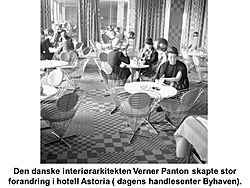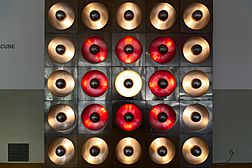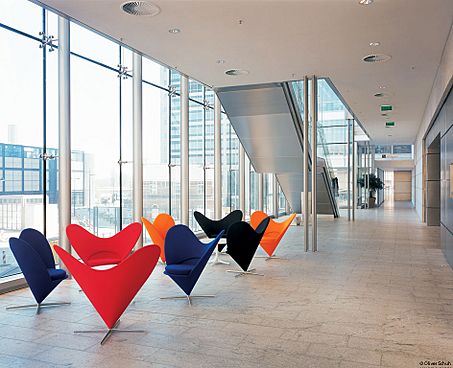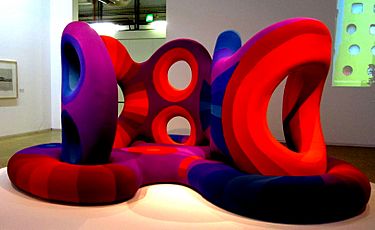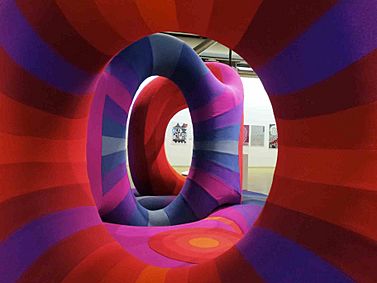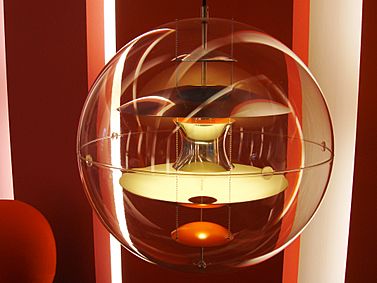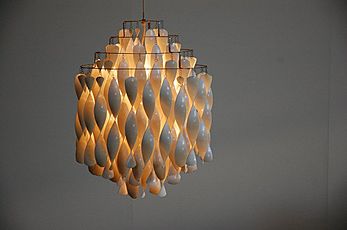Verner Panton facts for kids
Quick facts for kids
Verner Panton
|
|
|---|---|

Panton photographed by Erling Mandelmann
|
|
| Born | 13 February 1926 Gamtofte, Denmark
|
| Died | 5 September 1998 (aged 72) Copenhagen, Denmark
|
| Nationality | Danish |
| Occupation | Architect |
Verner Panton (born February 13, 1926 – died September 5, 1998) was a famous Danish designer. He is known as one of the most important furniture and interior designers of the 20th century.
Panton created new and futuristic designs. He often used plastics and bright, exciting colors. His style was very popular in the 1960s. Many of his best-known furniture pieces are still made today.
Contents
Verner Panton's Life Story
Verner Panton was born in Gamtofte, Denmark. He was already a skilled artist when he went to study architecture. He attended the Royal Danish Academy of Art in Copenhagen. He graduated in 1951.
From 1950 to 1952, Panton worked for Arne Jacobsen. Jacobsen was another famous Danish architect and furniture designer. Panton was very creative and had many new ideas. He soon started his own design office.
He became known for his unique building ideas. These included a house that could fold up (1955). He also designed a Cardboard House and a Plastic House (1960).
Creating New Chair Designs
In the late 1950s, Panton started making chairs that looked very different. They often had no legs or a clear back. In 1960, he designed the first plastic chair made from one single piece. This was called the Stacking chair or S chair. It was made in large numbers and became one of his most famous designs. It looked like a human tongue with its smooth, curved shape.
In the late 1960s and early 1970s, Verner Panton started designing whole rooms. These were often bold and colorful, like a dream world. He used his curved furniture, special wall coverings, fabrics, and lights. He is famous for designing rooms for Bayer's product shows. These shows were held on boats.
Verner Panton's Design Work

After working with Arne Jacobsen, Panton traveled around Europe for three years. He met many designers and manufacturers. This helped him get big projects. In 1955, he designed the Bachelor Chair and Trivoli Chair. These were made by a well-known Danish company called Fritz Hansen.
Early Chair Ideas
In the mid-1950s, Panton first thought about making a chair from just one piece. In 1956, he entered a design contest. He showed a whole furniture collection, including a stackable chair. This chair had its seat and backrest as one piece. This idea led to his famous 'S Chair'. His designs did not win the contest, but the idea was important. In 1957, he created a small series of ready-made weekend homes called the All Round House.
Designing the Kom-igen Inn
In 1958, Panton redesigned his parents' inn, Kom-igen. He designed the inside of the inn and added a roof terrace. He used five shades of red to make the rooms feel warm. He also used dark colors for table cloths. Panton created a flexible system of fabrics with geometric patterns. These could hang from the ceiling to divide the room. This project started his work with Danish companies like Plus-Linje (furniture), Unika Væv (textiles), and Louis Poulsen (lighting).
Hotel Astoria and Inflatable Furniture
In 1960, Panton designed the Astoria hotel restaurant in Trondheim, Norway. He designed the entrance, dining areas, and dance floor. He used special fabric designs for the floors, walls, and ceilings. This made the whole room look unified. The chairs were different versions of his cone chairs. At this time, Panton also designed the first inflatable chairs made of clear plastic.
Famous Designs and Exhibitions
In 1961, Panton showed his furniture, textiles, and lamps in a famous design magazine. In 1964, his Shell Lamps were shown for the first time. At the International Furniture Fair in Cologne, his Flying Chairs were a huge hit. In 1965, Thonet made Panton's S-Chair (Model 275). This was the first chair made from bent plywood that seemed to float.
In 1967, the Panton Chair was shown to the public. He also designed an exhibition called Visiona 0 for Bayer. Here, he showed his Flower Pot lamp. His Living Tower was shown at the Louvre in Paris.
Spiegel Publishing House
Panton designed the offices for the Spiegel Publishing House in Hamburg in 1969. He designed the entrance, lobby, canteen, bar, and even a swimming pool for employees. He also chose the colors for the hallways. He designed everything himself: lamps, textiles, and wall coverings. The special mirror lighting on walls and ceilings was very important. While some parts of the building were changed later, the canteen still looks like his original design.
Visiona Exhibitions
From the late 1960s to the mid-1970s, the Bayer chemical company rented a boat for a furniture fair. They asked famous designers to turn it into a showroom. Panton designed this exhibition twice, calling it 'Visiona'. In 1970, the 'Visiona 2' exhibition showed his "Fantasy Landscape." This room was filled with bright colors and curved shapes. It is seen as one of the most important room designs of the 20th century.
Later Works
In 1974, Panton designed the offices for the Gruner & Jahr Publishing House in Hamburg.
In 1977, Fritz Hansen started making his System 1-2-3 seating. In 1978, Louis Poulsen launched his VP Europa lighting range. Panton also designed the colors for a passage at the University Hospital in Basel. In 1984, The Circus Building in Copenhagen was renovated using Panton's color designs.
In 1990, the Panton Chair was made again by Vitra. In 1994, he designed the Vilbert Chair for Ikea. In 1995, he designed a Swatch Art Clock Tower for the Olympic Summer Games. This tower had 63 colorful rings and a large Swatch clock.
In 1996, Panton created a color installation called "Farbräume" in Basel. In 1997, he designed the Erco offices in London. His last exhibition, "Light and Colour," opened in 1998, just after he passed away.
Selected Works
Interior Design Projects
- Kom-igen Guest House
- Astoria Hotel and restaurant in Trondheim, Norway
- Visiona I & Visiona II exhibitions
- Private House at Binningen
- Gruner & Jahr Publishing House, Hamburg
- Pantorama exhibition
- Colour Spaces installation
- Exhibition Light and Colour at the Trapholt Museum, Kolding, DK
- Varna Restaurant (Arhus)
- University Hospital in Basel
- The Circus Building
- Erco Offices
- Exhibition Light and Colour
Furniture Designs
- Cone Chair
- Trivoli Chair
- Bachelor Chair
- Panton Chair
- System 1-2-3
- Vilbert Chair
- Pantoflex
- Sculpture Sofa
Lighting Designs
- Shell Lamp
- Panthella Lamp
- Flower Pot Lamp
- VP Europa lighting
- Spiral lamp
- Globe lamp
- Moon lamp
Textile Designs
Industrial Designs
- Swatch Art Clock Tower
- Candlesticks, vase collections, clocks, a television, Wega-Radio, mirror sculptures, enamel wall panels, toys, planters, glass wear, dining supplies, window coverings.
Architecture Projects
- All Round House
Awards and Recognition
Verner Panton received many awards for his designs:
- 1960s: International Design Award (USA, 1963, 1968), Rosenthal Studio Prize (Germany, 1966), Poul Henningsen Prize (Denmark, 1967).
- 1970s: Federal German ‘Gute Form’ Prize (Germany, 1972), Møbelprisen (Denmark, 1978).
- 1980s: International Design Award (USA, 1981, 1986), Sadolin Farve Prize (Denmark, 1986).
- 1990s: Dansk Designgråd Årspris prize (Denmark, 1991), IF Prize (Japan, 1992), Norway's Design Prize (Norway, 1992). In 1998, he received the Bo Bedre Prisen and was awarded the knight’s cross of the Dannebrog order by the Queen of Denmark.
- 2000s: The Vitra Design Museum held a special exhibition about him (2000). In 2012, a street in Weil am Rhein, Germany, was named Verner-Panton-Weg in his honor.
See also
 In Spanish: Verner Panton para niños
In Spanish: Verner Panton para niños



